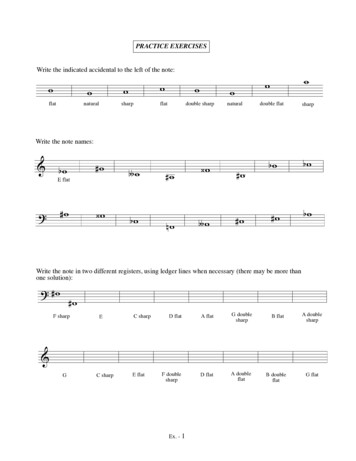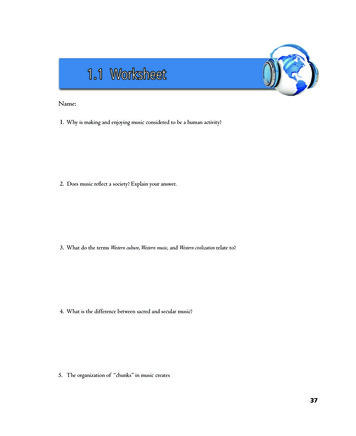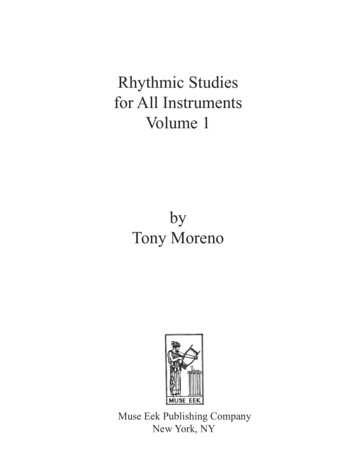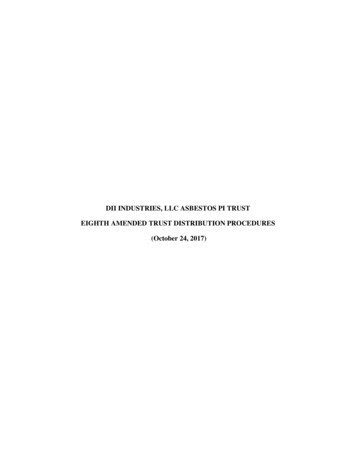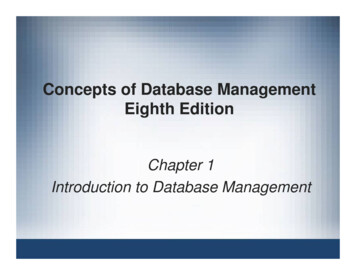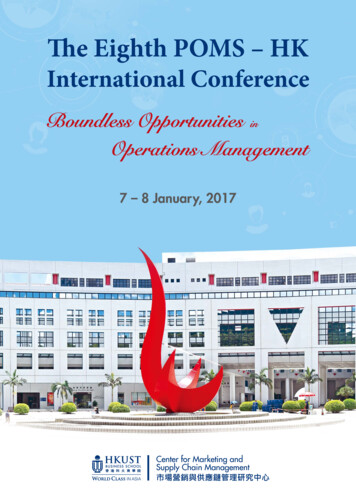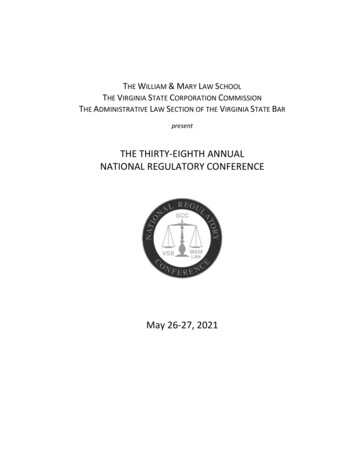
Transcription
THE WILLIAM & MARY LAW SCHOOLTHE VIRGINIA STATE CORPORATION COMMISSIONTHE ADMINISTRATIVE LAW SECTION OF THE VIRGINIA STATE BARpresentTHE THIRTY-EIGHTH ANNUALNATIONAL REGULATORY CONFERENCEMay 26-27, 2021
THE THIRTY-EIGHTH NATIONAL REGULATORY CONFERENCEWednesday, May 268:30 a.m.WelcomeAlisson P. Klaiber, Chair, Program CommitteeVice-Chair, Virginia State Bar Administrative Law SectionVirginia State Corporation CommissionThe Honorable Judith Williams JagdmannThe Honorable Jehmal T. HudsonThe Honorable Angela L. NavarroVirginia State Corporation CommissionA. Benjamin Spencer, Dean and Chancellor ProfessorThe William & Mary Law School8:45 a.m.Understanding the Virginia Clean Economy Act (“VCEA”)60 minutesPassed last year, the VCEA will lead to the adoption of unprecedented amounts ofrenewable generation and energy storage in Virginia, with a mandate for theCommonwealth’s two largest utilities to achieve net-zero emissions in the next25 to 30 years. The panel will discuss the purpose and implementation of the VCEA, andthe opportunities and challenges presented by the new law.Moderator:David J. DePippoSenior Counsel, Dominion Energy Services, Inc.Panelists:The Honorable Richard C. “Rip” Sullivan, Jr.48th District, Virginia House of DelegatesSarah VogelsongEnvironment and Energy Reporter, The Virginia Mercury9:45 a.m.Break10:00 a.m.The Pathways to Net Zero by 2045/205060 minutesPanelists will discuss Virginia’s pathways to net zero with an ever-evolving portfolioof generation assets and the impact on grid resilience in light of current events.Moderator:Andrew M. VehornVice President of Government AffairsThe Virginia, Maryland & Delaware Association of Electric Cooperatives2
Panelists:Jesse D. Jenkins, PhDAssistant ProfessorDepartment of Mechanical and Aerospace Engineering andthe Andlinger Center for Energy and Environment, Princeton UniversityDarlene PhillipsExecutive Director, Operations Engineering SupportPJM Interconnection, LLC11:00 a.m.Break11:15 a.m.The Interplay between the VCEA and Federal and State Policies, including theRegional Greenhouse Gas Initiative (RGGI).60 minutesPanelists will explore the role of the VCEA in the broader framework of Virginiaand Federal energy policies, including Virginia’s participation in RGGI.Moderator:William C. Cleveland IVSenior Attorney, Southern Environmental Law CenterPanelists:Michael G. DowdDirector, Air & Renewable Energy DivisionVirginia Department of Environmental QualityKate KonschnikDirector, Climate and Energy ProgramNicholas Institute for Environmental Policy Solutions, Duke University12:15 p.m.Program concludes for the day. The legal ethics session will start at 1 p.m.1-3 p.m.Confidentiality: Part II (Exceptions to the Duty)2 hoursThis interactive program uses hypotheticals to explore exceptions to lawyers'confidentiality duty. Among other things, the program will address lawyers disclosingclient confidential information: in the context of joint representations and commoninterest agreements; when complying with laws or court orders; in clearing conflicts ofinterest on a daily basis and when hiring laterals; when defending themselves fromclients' and non-clients' claims or criticism; in seeking to collect their fees or withdraw ascounsel of record.Thomas E. Spahn, a Partner at the McGuireWoods law firm, and nationally knownexpert on ethics, will lead an informative and interactive session using challenginghypotheticals to address current ethical issues of interest to all attorneys.3
THE THIRTY-EIGHTH NATIONAL REGULATORY CONFERENCEThursday, May 279:00 a.m.90 minutesRegional Roundup: The Impacts of FERC's Minimum Offer Price Rule Expansion inPJM InterconnectionThis panel will discuss the current status and future of PJM’s regional electric capacitymarket, following significant changes to its Minimum Offer Price Rule (MOPR). Panelistswill address the impact of recent FERC orders expanding the MOPR to state-subsidizedresources. The panel will also identify jurisdictional issues that are the subject of apending appeal, including how FERC’s wholesale market jurisdiction intersects withState policies and jurisdiction over electric generation. The panel will also look to thefuture of PJM’s capacity market based on recent developments -- including a FERCtechnical conference on resource adequacy and capacity market workshops convenedby PJM.Moderator:D. Mathias Roussy, Jr.Hearing Examiner, Virginia State Corporation CommissionPanelists:The Honorable Kimberly W. DuffleyNorth Carolina Utilities CommissionThe Honorable Jason M. StanekMaryland Public Service CommissionJoseph E. Bowring, PhDPresident, Monitoring Analytics, LLCIndependent Market Monitor for PJMLisa MorelliDirector – Market DesignPJM Interconnection, LLCTed J. MurphyPartner, Hunton Andrews Kurth LLP10:30 a.m.Break4
10:45 a.m.90 minutesCan Distributed Energy Resources and Storage Meaningfully Participate in theWholesale Markets?This panel will explore the options available for Distributed Energy Resources ("DERs")and Energy Storage participation in the wholesale marketplace. Panelists will discussFERC's Orders 2222 (DER Participation in Wholesale Markets) and 841 (StorageParticipation in Wholesale Markets), providing insight into wholesale marketplace entryrequirements, barriers to entry, jurisdictional considerations and the pros and cons ofeach.Moderator:Colleen A. Lueken, PhDLead Data Scientist, FluencePanelists:Scott BakerSr. Business Solutions Analyst, Applied InnovationPJM Interconnection, LLCRicky Elder IIIManager – Business Development Energy StorageRegulated Power GenerationDominion EnergyMichael HerbertManaging Partner/Co-Founder, Delorean Power LLC12:15Conference concludesThe program is approved for 8 hours of Virginia Continuing Legal Education (CLE) credit which includes 2.0hours of ethics credits.5
PROGRAM COMMITTEEAlisson P. Klaiber, Esq.Virginia State Corporation CommissionVice Chair, VSB Administrative Law SectionChair, Program CommitteeJames G. Ritter, Esq.Hunton Andrews Kurth LLPChair, VSB Administrative Law SectionFrederick D. Ochsenhirt, Esq.Virginia State Corporation CommissionSecretary, VSB Administrative Law SectionK. Beth Clowers, Esq.Virginia State Corporation CommissionImmediate Past Chair, VSB AdministrativeLaw SectionRaymond L. Doggett, Jr., Esq.Virginia State Corporation CommissionK. Rebecca T. GliddenColumbia Gas of Virginia, Inc.Matthew L. Gooch, Esq.ReisingerGooch, PLCCale A. Jaffe, Esq.University of Virginia School of LawTyler W. LakeVirginia Natural Gas, Inc.Matthew G. LaRocquePJM Interconnection, LLCSarah R. Bennett, Esq.McGuireWoods LLPTrieste Lockwood, Esq.Office of the GovernorTimothy E. Biller, Esq.Hunton Andrews Kurth LLPAshley B. Macko, Esq.Virginia State Corporation CommissionJoyce B. BodohRappahannock Electric CooperativeBernice K. McIntyre, Esq.The BKM GroupSamuel R. Brumberg, Esq.The Virginia, Maryland & Delaware Associationof Electric CooperativesCarol Barrow MyersSouthside Electric CooperativeGarland S. Carr, Esq.Williams Mullen, PCWilliam C. Cleveland, IV, Esq.Southern Environmental Law CenterKelli J. Cole, Esq.Virginia State Corporation CommissionLisa R. Crabtree, Esq.McGuireWoods LLPDavid J. DePippo, Esq.Dominion Energy Services, Inc.William T. Reisinger, Esq.ReisingerGooch, PLCCliona M. Robb, Esq.ThompsonMcMullan, P.C.Margaret D. SacksVirginia State Corporation CommissionRichard A. SchollmannVA Telecommunications Industry AssociationHoward M. SpinnerNorthern Virginia Electric CooperativeEric J. Wallace, Esq.GreeneHurlocker, PLC6
Table of ContentsPanel 1:Understanding the Virginia Clean Economy Act (“VCEA”)1. Outline2. Speaker Biographies3. Reference Materialsa. Virginia Clean Economy Act (2020 HB 1526)b. Ten Things to Know about the Clean Economy Act – Virginia Mercuryc. Virginia Clean Energy Transition Series – Virginia MercuryPanel 2:The Pathways to Net Zero by 2045/20504. Outline5. Speaker Biographies6. Reference Materialsa. Presentation by Jesse Jenkins. Net-Zero America- Potential Pathways, Infrastructure,and Impacts.b. Testimony of Jesse Jenkins in the U.S. House Science, Space & Technology Committeehearing on Lessons Learned From the Texas Blackouts: Research Needs for a Secure andResilient Grid on March 18, 2021c. Executive Summary of the Net-Zero America StudyFull report available at https://netzeroamerica.princeton.edu/the-reportd. Long, Jane C.S., Ejeong Baik, Jesse D. Jenkins, Clea Kolster, Kiran Chawla, ArneOlson, Armond Cohen, Michael Colvin, Sally M. Benson, Robert B. Jackson, DavidG. Victor, and Steven P. Hamburg. “Clean Firm Power is the Key to California’sCarbon-Free Energy Future.” Issues in Science and Technology (March 24, 2021).e. Testimony of Manu Asthana (PJM Interconnection) in the U.S. Senate Committee onEnergy & Natural Resources Hearing on The Reliability, Resiliency and Affordability ofElectric Service in the United State Amid the Changing Energy Mix and Extreme WeatherEvents on March 11, 2021Questions for the Record Submitted to Mr. Manu Asthana (online only)Panel 3:The Interplay between the VCEA and Federal and State Policies,including the Regional Greenhouse Gas Initiative (RGGI)7. Outline8. Speaker Biographies9. Reference Materialsa. RGGI CO2 Emissions Monitoring Report (2018)b. Environmental Justice Study for the Virginia DEQ (2020)c. 2020 Environmental Justice Interagency Working Group Report (online only)d. Executive SummaryKonschnik, K., M. Ross, J. Monast, J. Weiss, and G. Wilson. Power Sector CarbonReduction: An Evaluation of Policies for North Carolina. NI R 21-01. Durham, NC: DukeUniversity.
Full report may be found here- Power Sector Carbon Reduction: An Evaluation ofPolicies for North Carolina The Nicholas Institute for Environmental Policy Solutions(duke.edu)e. Waldman, Scott. Biden’s Infrastructure Plan Would Make Electricity Carbon-Free by2035. E&E News. April 1, 2021.Panel 4:Regional Roundup: The Impacts on FERC’s Minimum Offer PriceRule Expansion in PJM Interconnection10. Outline- Legal Background of PJM’s Minimum Offer Price Rule (MOPR)a. 2006: Creation of PJM’s Capacity Auction Process, including a MOPR and Opt-Outb. 2011 – 2017: Substantial MOPR Modifications and an Appellate Reversalc. 2018 – Present: Expanding the MOPR to State-Subsidized Resources, Including ExistingResources, and a Pending Appeal11. Speaker Biographies12. Reference Materialsa. FERC Directs PJM to Expand Minimum Offer Price Rule Press Releaseb. Calpine Corp., et al v. PJM Interconnection, LLC,Link to the Full Order- 169 FERC ¶ 61,239, Order Establishing Just and Reasonable Rate(Dec. 19, 2019) (online only)c. Hollow Road Solar LLC174 FERC ¶ 61,200, Order on Petition for Declaratory Judgment (Mar. 18, 2021)d. Modernizing Electricity Market DesignNotice Inviting Post-Technical Conference Comments (Apr. 5, 2021)e. PJM Board Letter regarding the Capacity Market, April 6, 2021Panel 5:Can Distributed Energy Resources and Storage MeaningfullyParticipate in the Wholesale Markets?13. Outline14. Speaker Biographies15. Reference Materialsa. Presentation by Colleen Lueken, Fluence.b. Presentation by Scott Baker, PJM. Energy Storage Resources: Evolving Opportunities inPJM.c. Presentation by Ricky Elder, Dominion Energy. Energy Storage DevelopmentPerspectives.d. Presentation by Michael Herbert, Delorean Power. Regulatory Considerations for EnergyStorage.e. The Need for Speed: Supporting Rapid Decarbonization with the World’s Fastest GridScale Battery White Paper issued by Fluence. 2020f. Colthorpe, Andy. Virginia enacts regulations to enable US’ largest procurement targetfor energy storage. Energy Storage News. January 13, 2021.g. California Public Utilities Commission Energy Storage information.h. Maloney, Peter. New York sets 3 GW storage target, doubles efficiency goals for utilities.Utility Dive. December 14, 2018.i. Burwen, Jason. Energy Storage Goals, Targets, Mandates: What’s the Difference? TheESA (Energy Storage Association) Blog. April 24, 2020.
j.FERC Order 841- Electric Storage Participation in Markets Operated by RegionalTransmission Organizations and Independent System Operators162 FERC ¶ 61,127Link to the Full Order- https://www.ferc.gov/media/order-no-841 (online only)k. FERC Order No. 2222: A New Day for Distributed Energy Resources News Release andFact Sheet. September 17, 2020.Link to the Full Order- ion-breaks-down (online only)l.m.n.o.p.North American Electric Reliability Corporation (NERC) Report. Energy Storage- Impactsof Electrochemical Utility-Scale Battery Energy Storage Systems on the Bulk PowerSystem. February 2021.Sepulveda, N.A., Jenkins, J.D., Edington, A. et al. The design space for long-durationenergy storage in decarbonized power systems. Nat Energy he design space for long-duration energy storage in decarbonized powersystems Nature Energy (online only)Comments by the U.S. Energy Storage Association in Support of PJM’s Effective LoadCarrying Capability Construct in FERC Docket Nos. ER21-278-000. April 6, 2021.Energy Storage Association ELCC summary and links to FERC proceeding:ESA Urges FERC Timely Approval of PJM Capacity Accreditation Reforms forStorage and Other Resources - Energy Storage Association (online only)FERC Order No. 845: Reform of Generator Interconnection Procedures and Agreements163 FERC ¶ 61,043, April 19, 2018.Link to the Full Order- Order-845.pdf (ferc.gov) (online only)California Public Utilities Rulemaking 15-03-011. Order Instituting Rulemaking toconsider policy and implementation refinements to the Energy Storage ProcurementFramework and Design Program (D.13-10-040, D.14-10-045) and related Action Plan ofthe California Energy Storage Roadmap. January 17, 2018.206462341.pdf (ca.gov) (online only)
Panel 1:Understanding the Virginia Clean Economy Act (“VCEA”)Passed last year, the VCEA will lead to the adoption of unprecedented amounts of renewablegeneration and energy storage in Virginia, with a mandate for the Commonwealth’s two largestutilities to achieve net-zero emissions in the next 25 to 30 years. The panel will discuss thepurpose and implementation of the VCEA, and the opportunities and challenges presented bythe new law.Moderator:David J. DePippoSenior Counsel, Dominion Energy Services, Inc.Panelists:The Honorable Richard C. “Rip” Sullivan, Jr.48th District, Virginia House of DelegatesSarah VogelsongEnvironment and Energy Reporter, The Virginia MercuryOutline1. Introduction – overview of the VCEA, discussing key provisions, policy goals, andchanges to Virginia’s energy landscape.2. VCEA Transition – the panelists will contextualize the VCEA during this discussion ofVirginia before the VCEA, where we stand now with the VCEA, and where we go fromhere.3. VCEA Policy - the panelists will discuss the key policy drivers behind the VCEA overall,as well as specific components of the VCEA and recent related energy legislationaddressing such topics as the Regional Greenhouse Gas Initiative, Solar Freedom,Environmental Justice, and solar siting issues.4. Political Process Behind the VCEA – the panelists will discuss the political andlegislative process behind the VCEA and the inner workings that led to this landmarkpiece of legislation.5. VCEA Implementation and Status - the panelists will discuss the status of recentproceedings and administrative processes to implement the VCEA and related policies,including the VCEA’s renewable portfolio standard and Virginia’s decision to participatein RGGI.6. Audience Q&A
Speaker BiographiesDavid J. DePippoSenior Counsel, Dominion Energy Services, Inc.David J. DePippo is Senior Counsel with Dominion Energy, wherehe assists the company with state and federal regulatory matters,including the development and permitting of renewable energyprojects. Prior to working for Dominion Energy, he was in privatepractice for fifteen years, with the law firms of Hunton & Williams(now Hunton Andrews Kurth) and Gallagher & Kennedy, focusingon environmental, energy, and mining law. Before becoming alawyer, David served in the United States Coast Guard.***The Honorable Richard C. “Rip” Sullivan, Jr.48th District, Virginia House of Delegates"Richard “Rip” Sullivan, Jr. and his wife, Beth, were bothraised and attended public schools in Northern Virginia.Before being elected to the House of Delegates in 2014,Rip served our region on numerous boards andcommissions, which are listed here, providing him withextensive experience in a number of key policy areas thathave directly translated to his work for the 48th District.Rip is Chair of the House Democratic Caucus, a leadershiprole in which he works with Speaker Eileen Filler-Corn andMajority Leader Charniele Herring to promote the goals ofHouse Democrats. Rip served two terms as the HouseDemocratic Caucus Campaign Chair, during which time heled the Democratic Party’s effort to gain seats and win backthe majority in the House. He became Campaign Chair in2017 and oversaw the strategy that led House Democratsto pick up a whopping 15 seats. He reprised his role as Campaign Chair during the 2019 cycle inwhich Democrats made history by taking back both the House and Senate.As a Delegate, Rip has fought every year to encourage the growth of Virginia's clean energy andenergy efficiency sectors, promote access to the ballot box, protect and advance LGBTQ rights, andde-politicize the redistricting process. Speaker Filler-Corn appointed Rip to serve as Chair of thepowerful Labor and Commerce Committee’s Energy Subcommittee, a role in which he used hisexperience legislating in the energy space to help shape the way Virginia moves forward on thesecrucial issues. He also serves as Chair of the Finance Committee's Third Subcommittee whichconsiders bills related to corporate and individual income tax. Additionally, Rip serves on the RulesCommittee and Courts of Justice Committee.
During the 2020 session Rip introduced the historic Virginia Clean Economy Act to advance theCommonwealth's clean energy sector and promote energy efficiency and a life-saving "Red Flag"law to curb gun violence before a single shot is fired, among other significant pieces of legislation.Rip worked diligently with stakeholders and his colleagues to ultimately ensure that these landmarkbills became law.Rip and Beth, his high school sweetheart, have four children, all of whom graduated from our publicschools. They have two granddaughters, Alex and Avery, and one grandson, Taylor.Rip graduated magna cum laude from Amherst College, and received his law degree from theUniversity of Virginia. He is a partner in the law firm Bean Kinney & Korman, P.C., in Arlington."***Sarah VogelsongEnvironment and Energy Reporter, The Virginia MercurySarah Vogelsong is an environment and energy reporter for theVirginia Mercury in Richmond, where she covers everything fromutility regulation to the General Assembly to sea level rise. Shepreviously worked as a staff reporter for Chesapeake Bay Journal,the Progress-Index and the Caroline Progress and was honored bythe Virginia Press Association as the 2020 "Best in Show" for onlinewriting for her reporting on two natural gas plants planned forCharles City County. She was chosen for the 2020 cohort of theColumbia Energy Journalism Institute and is a graduate of theCollege of William and Mary.***
VIRGINIA ACTS OF ASSEMBLY -- 2020 SESSIONCHAPTER 1193An Act to amend and reenact §§ 10.1-1308, 56-576, 56-585.1, 56-585.1:4, 56-594, and 56-596.2 of theCode of Virginia and § 1 of the first enactment of Chapters 358 and 382 of the Acts of Assembly of2013, as amended by Chapter 803 of the Acts of Assembly of 2017; to amend the Code of Virginiaby adding sections numbered 56-585.1:11, 56-585.5, and 56-585.6; and to repeal § 56-585.2 of theCode of Virginia, relating to the regulation of electric utilities; ending carbon dioxide emissions;construction or acquisition of renewable energy facilities; renewable portfolio standards for electricutilities and suppliers; energy efficiency programs and standards; energy storage; net energymetering; third-party power purchase agreements; and the Percentage of Income Payment Program.[H 1526]Approved April 11, 2020Be it enacted by the General Assembly of Virginia:1. That §§ 10.1-1308, 56-576, 56-585.1, 56-585.1:4, 56-594, and 56-596.2 of the Code of Virginiaand § 1 of the first enactment of Chapters 358 and 382 of the Acts of Assembly of 2013, asamended by Chapter 803 of the Acts of Assembly of 2017, are amended and reenacted and thatthe Code of Virginia is amended by adding sections numbered 56-585.1:11, 56-585.5, and 56-585.6as follows:§ 10.1-1308. Regulations.A. The Board, after having studied air pollution in the various areas of the Commonwealth, itscauses, prevention, control and abatement, shall have the power to promulgate regulations, includingemergency regulations, abating, controlling and prohibiting air pollution throughout or in any part of theCommonwealth in accordance with the provisions of the Administrative Process Act (§ 2.2-4000 et seq.),except that a description of provisions of any proposed regulation which are more restrictive thanapplicable federal requirements, together with the reason why the more restrictive provisions are needed,shall be provided to the standing committee of each house of the General Assembly to which mattersrelating to the content of the regulation are most properly referable. No such regulation shall prohibit theburning of leaves from trees by persons on property where they reside if the local governing body of thecounty, city or town has enacted an otherwise valid ordinance regulating such burning. The regulationsshall not promote or encourage any substantial degradation of present air quality in any air basin orregion which has an air quality superior to that stipulated in the regulations. Any regulations adopted bythe Board to have general effect in part or all of the Commonwealth shall be filed in accordance withthe Virginia Register Act (§ 2.2-4100 et seq.).B. Any regulation that prohibits the selling of any consumer product shall not restrict the continuedsale of the product by retailers of any existing inventories in stock at the time the regulation ispromulgated.C. Any regulation requiring the use of stage 1 vapor recovery equipment at gasoline dispensingfacilities may be applicable only in areas that have been designated at any time by the U.S.Environmental Protection Agency as nonattainment for the pollutant ozone. For purposes of this section,gasoline dispensing facility means any site where gasoline is dispensed to motor vehicle tanks fromstorage tanks.D. No regulation of the Board shall require permits for the construction or operation of qualifiedfumigation facilities, as defined in § 10.1-1308.01.E. Notwithstanding any other provision of law and no earlier than July 1, 2024, the Board shalladopt regulations to reduce, for the period of 2031 to 2050, the carbon dioxide emissions from anyelectricity generating unit in the Commonwealth, regardless of fuel type, that serves an electricitygenerator with a nameplate capacity equal to or greater than 25 megawatts that supplies (i) 10 percentor more of its annual net electrical generation to the electric grid or (ii) more than 15 percent of itsannual total useful energy to any entity other than the manufacturing facility to which the generatingsource is interconnected (covered unit).The Board may establish, implement, and manage an auction program to sell allowances to carryout the purposes of such regulations or may in its discretion utilize an existing multistate tradingsystem.The Board may utilize its existing regulations to reduce carbon dioxide emissions from electric powergenerating facilities; however, the regulations shall provide that no allowances be issued for coveredunits in 2050 or any year beyond 2050. The Board may establish rules for trading, the use of bankedallowances, and other auction or market mechanisms as it may find appropriate to control allowancecosts and otherwise carry out the purpose of this subsection.In adopting such regulations, the Board shall consider only the carbon dioxide emissions from the
2 of 33covered units. The Board shall not provide for emission offsetting or netting based on fuel type.Regulations adopted by the Board under this subsection shall be subject to the requirements set outin §§ 2.2-4007.03, 2.2-4007.04, 2.2-4007.05, and 2.2-4026 through 2.2-4030 of the AdministrativeProcess Act (§ 2.2-4000 et seq.) and shall be published in the Virginia Register of Regulations.§ 56-576. Definitions.As used in this chapter:"Affiliate" means any person that controls, is controlled by, or is under common control with anelectric utility."Aggregator" means a person that, as an agent or intermediary, (i) offers to purchase, or purchases,electric energy or (ii) offers to arrange for, or arranges for, the purchase of electric energy, for sale to,or on behalf of, two or more retail customers not controlled by or under common control with suchperson. The following activities shall not, in and of themselves, make a person an aggregator under thischapter: (i) furnishing legal services to two or more retail customers, suppliers or aggregators; (ii)furnishing educational, informational, or analytical services to two or more retail customers, unless director indirect compensation for such services is paid by an aggregator or supplier of electric energy; (iii)furnishing educational, informational, or analytical services to two or more suppliers or aggregators; (iv)providing default service under § 56-585; (v) engaging in activities of a retail electric energy supplier,licensed pursuant to § 56-587, which are authorized by such supplier's license; and (vi) engaging inactions of a retail customer, in common with one or more other such retail customers, to issue a requestfor proposal or to negotiate a purchase of electric energy for consumption by such retail customers.(Expires December 31, 2023) "Business park" means a land development containing a minimum of100 contiguous acres classified as a Tier 4 site under the Virginia Economic Development Partnership'sBusiness Ready Sites Program that is developed and constructed by an industrial development authority,or a similar political subdivision of the Commonwealth created pursuant to § 15.2-4903 or other act ofthe General Assembly, in order to promote business development and that is located in an area of theCommonwealth designated as a qualified opportunity zone by the U.S. Secretary of the Treasury via hisdelegation of authority to the Internal Revenue Service."Combined heat and power" means a method of using waste heat from electrical generation to offsettraditional processes, space heating, air conditioning, or refrigeration."Commission" means the State Corporation Commission."Community in which a majority of the population are people of color" means a U.S. Census tractwhere more than 50 percent of the population comprises individuals who identify as belonging to one ormore of the following groups: Black, African American, Asian, Pacific Islander, Native American, othernon-white race, mixed race, Hispanic, Latino, or linguistically isolated."Cooperative" means a utility formed under or subject to Chapter 9.1 (§ 56-231.15 et seq.)."Covered entity" means a provider in the Commonwealth of an electric service not subject tocompetition but shall does not include default service providers."Covered transaction" means an acquisition, merger, or consolidation of, or other transactioninvolving stock, securities, voting interests or assets by which one or more persons obtains control of acovered entity."Curtailment" means inducing retail customers to reduce load during times of peak demand so as toease the burden on the electrical grid."Customer choice" means the opportunity for a retail customer in the Commonwealth to purchaseelectric energy from any supplier licensed and seeking to sell electric energy to that customer."Demand response" means measures aimed at shifting time of use of electricity from peak-useperiods to times of lower demand by inducing retail customers to curtail electricity usage during periodsof congestion and higher prices in the electrical grid."Distribute," "distributing," or "distribution of" electric energy means the transfer of electric energythrough a retail distribution system to a retail customer."Distributor" means a person owning, controlling, or operating a retail distribution system to provideelectric energy directly to retail customers."Electric distribution grid transformation project" means a project associated with electric distributioninfrastructure, including related data analytics equipment, that is designed to accommodate or facilitatethe integration of utility-owned or customer-owned renewable electric generation resources with theutility's electric distribution grid or to otherwise enhance electric distribution grid reliability, electricdistribution grid security, customer service, or energy efficiency and conservation, including advancedmetering infrastructure; intelligent grid devices for real time system and asset information; automatedcontrol systems for electric distribution circuits and substations; communications networks for servicemeters; intelligent grid devices and other distribution equipment; distribution system hardening projectsfor circuits, other than the conversion of overhead tap lines to underground service, and substationsdesigned to reduce service outages or service restoration times; physical security measures at keydistribution substations; cyber security measures; energy storage systems and microgrids that supportcircuit-level grid stability, power quality, reliability, or resiliency or provide temporary backup energysupply; electrical facilities and infrastructure necessary to support electric vehic
THE THIRTY-EIGHTH NATIONAL REGULATORY CONFERENCE Wednesday, May 26 8:30 a.m. Welcome Alisson P. Klaiber, Chair, Program Committee Vice-Chair, Virginia State Bar Administrative Law Section Virginia State Corporation Commission The Honorable Judith Williams Jagdmann The H



